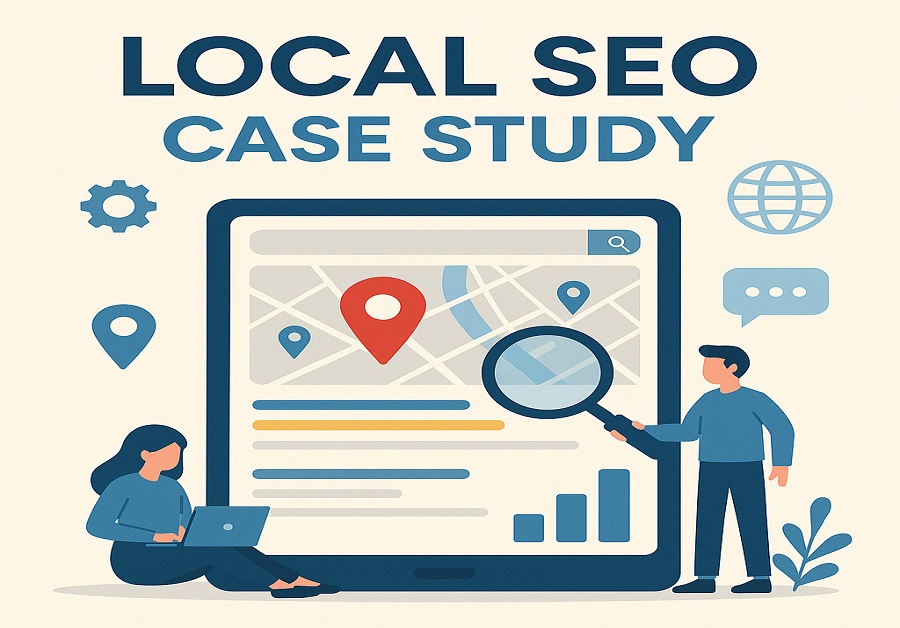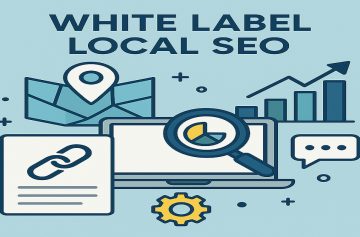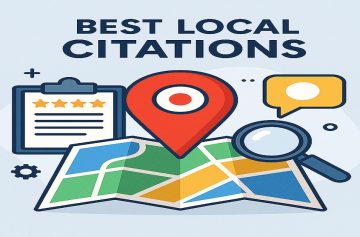Local SEO and Its Importance
Local SEO is a critical strategy for businesses that aim to attract more customers from their local area. It involves optimizing a website and online presence to appear in local search results on platforms like Google. By improving local visibility, businesses can stand out from competitors, increase foot traffic, and boost sales. In this section, we will explore the basics of local SEO, why it matters for small businesses, and provide an overview of our local SEO case study.
What is Local SEO?
Local SEO refers to the practice of optimizing a business’s online presence to rank higher in local search results. This includes using location-based keywords, creating location-specific content, and managing business profiles on platforms like Google My Business. By doing so, businesses ensure that they appear in front of users who are searching for products or services nearby. The goal is to connect businesses with local customers who are actively seeking their offerings.
Why Local SEO Matters for Small Businesses
For small businesses, local SEO is essential because it allows them to compete effectively with larger companies. Many consumers today turn to search engines when looking for businesses nearby, so having a strong local SEO presence increases the chances of being found by potential customers. Some of the key reasons why local SEO matters include:
- Higher Visibility: Being found on local search results puts your business in front of customers who are searching for services or products in your area.
- Better Conversion Rates: Local customers are often closer to making a purchase decision, making them more likely to convert once they find your business online.
- Cost-Effective Marketing: Local SEO is a more affordable and sustainable marketing strategy compared to traditional advertising methods, offering long-term benefits.
Overview of Our Local SEO Case Study
In this case study, we will walk you through the process of implementing local SEO for a small business. From identifying the challenges and setting goals to executing a tailored SEO strategy, this case study will highlight how effective local SEO can drive significant improvements in organic traffic, rankings, and customer engagement. By the end of this article, you will gain insights into how local SEO can be a game-changer for small businesses looking to grow in their local market.
The Challenge: Identifying the Business’s Needs
Before implementing any SEO strategy, it’s important to first understand the unique needs of the business. In this section, we’ll explore the situation before SEO optimization, identify the challenges that were hindering the business’s local visibility, and discuss the goals we set to improve its online presence.
The Business Before SEO Optimization
Before we began the SEO optimization process, the business struggled with poor local visibility. It had a basic website, but there were several issues that prevented it from being found by local customers:
- Limited Online Presence: The business wasn’t showing up in local search results, especially on Google. Most of its online traffic came from general searches, with very few visitors specifically from its target geographic area.
- Outdated Google My Business Profile: The business had a Google My Business (GMB) profile, but it was incomplete, not regularly updated, and lacked customer reviews or any relevant content that could attract local users.
- No Focus on Local Content: The website didn’t have location-specific content or service area pages to target customers within the local community. Without this, search engines weren’t able to connect the business to the local market effectively.
Key Issues Affecting Local Visibility
Several factors were affecting the business’s local visibility:
- Inconsistent NAP Information: The business’s Name, Address, and Phone Number (NAP) were not consistent across various platforms, which confused both search engines and potential customers. This inconsistency led to lower rankings in local search results.
- Lack of Local Keywords: The business’s website didn’t feature enough location-specific keywords that would signal to search engines it was relevant to users in the area.
- Limited Customer Reviews: The business had very few reviews on Google and other review platforms, which negatively impacted its credibility and search rankings.
- Low Local Citations: The business wasn’t listed in local directories or on other trusted local platforms, which made it harder for search engines to validate its authority in the community.
Setting the SEO Goals
To turn the situation around, we set clear, measurable SEO goals that would guide the optimization process. The goals were:
- Increase Local Search Visibility: The primary objective was to improve the business’s visibility in local search results by ensuring it appeared in top positions for relevant local queries.
- Boost Organic Traffic: Our goal was to drive more targeted traffic to the website, specifically from users in the business’s service area.
- Improve Customer Engagement: We aimed to enhance the engagement level by encouraging customer reviews and interactions on the Google My Business profile and the website.
- Increase Conversions: Ultimately, we wanted to increase the number of visitors who took action on the website, whether by calling the business, filling out contact forms, or visiting the physical location.
Our Approach to Local SEO
After identifying the business’s needs and setting clear SEO goals, we crafted a strategic approach to optimize its online presence for local search. The following steps were essential in driving success and improving local visibility for the business.
Keyword Research and Selection
Keyword research is a foundational step in any SEO strategy, particularly when targeting local search. For this campaign, we focused on identifying location-specific keywords that would connect the business with local customers. Our approach included:
- Identifying Relevant Local Keywords: We researched keywords that were commonly searched by potential customers in the area. For instance, if the business offered plumbing services, we targeted phrases like “plumber in [city name]” and “emergency plumbing services near me.”
- Long-Tail Keywords: We included long-tail keywords that were highly specific to the local market, such as “best plumber in [neighborhood name].” These keywords typically have lower competition and higher conversion potential.
- Competitor Analysis: We analyzed local competitors to identify the keywords they were ranking for. This provided valuable insights into market trends and helped refine our keyword strategy. By using these targeted keywords, we ensured the website would be optimized for the local audience, driving relevant traffic to the site.
Optimizing Google My Business Profile
Google My Business (GMB) is one of the most powerful tools for local SEO. Optimizing this profile was a critical part of our strategy:
- Accurate NAP Information: We ensured that the business’s Name, Address, and Phone Number (NAP) were consistent and accurate across all platforms and online listings.
- Complete and Engaging Profile: We updated the business’s GMB profile with all relevant information, including business hours, a detailed description, website link, and high-quality images showcasing the business.
- Customer Reviews: We encouraged happy customers to leave positive reviews on the GMB profile. Reviews are a key ranking factor for local search, and having a strong collection of reviews helped improve the business’s credibility and local ranking.
- Google Posts and Updates: Regularly posting updates, promotions, or events on the GMB profile kept the business active in the eyes of both Google and potential customers.
Building Local Citations and NAP Consistency
Local citations—mentions of the business’s NAP information across other websites—are crucial for establishing authority and improving local search rankings. To improve the business’s citation profile, we focused on:
- Local Business Directories: We listed the business on key local and industry-specific directories, ensuring its NAP was consistent across all platforms.
- NAP Consistency: We meticulously checked that the business’s Name, Address, and Phone Number were exactly the same across every listing. Inconsistent NAP information can harm local rankings and confuse customers.
- Additional Citations: We sought out other reputable platforms like Yelp, Yellow Pages, and local chamber of commerce websites to list the business, increasing its chances of being found in local search results.
On-Page SEO Optimization for Local Search
On-page SEO is essential to ensure that the website itself is optimized for local search. Here’s how we focused on improving on-page elements for better local search performance:
- Location-Specific Content: We created dedicated service area pages that targeted specific local keywords. These pages included detailed information about services offered in each area, making it clear that the business served multiple regions.
- Optimized Title Tags and Meta Descriptions: We updated the website’s title tags and meta descriptions to include local keywords, ensuring that the pages were optimized for local search queries.
- Local Schema Markup: We implemented local business schema markup to help search engines better understand the business’s location and services. This markup also helped improve visibility in local search features, such as the Local Pack and Google Maps.
- Mobile Optimization: Since many local searches are made on mobile devices, we made sure the website was fully mobile-optimized, providing a seamless experience for users searching from smartphones and tablets.
Implementation of Local SEO Strategies
After identifying the core areas for improvement, we focused on the practical implementation of various local SEO strategies. These strategies were designed to enhance the business’s online presence and visibility in local search results, ensuring that it attracted more local customers and grew its presence in the community.
Local Content Creation and Optimization
Creating high-quality, locally relevant content is a key factor in boosting local SEO. For this business, we focused on:
- Service Area Pages: We developed dedicated pages for each location the business served. These pages included local keywords and provided detailed information about the specific services available in each area. This not only helped improve local rankings but also ensured that visitors found the content highly relevant to their needs.
- Blog Posts with Local Focus: We created blog content that catered to local topics, events, and concerns. For example, a plumbing business might write about how to prepare your home’s plumbing system for winter in a particular city. This kind of content resonated with the local audience and helped establish the business as an expert in the local area.
- Optimizing Existing Content: We optimized existing pages by adding location-specific keywords to titles, headings, and body text. By focusing on local search terms, we made sure that the content would appear when potential customers searched for services in their area.
Customer Reviews and Testimonials for Local SEO
Customer reviews are one of the most important ranking factors for local SEO. Positive reviews not only enhance a business’s reputation but also improve its local search rankings. To take advantage of this, we focused on:
- Encouraging Customer Reviews: We proactively asked satisfied customers to leave reviews on Google My Business, Yelp, and other local review sites. Reviews act as social proof, building trust with potential customers and signaling to Google that the business is legitimate and trusted by its community.
- Responding to Reviews: We made sure to respond to both positive and negative reviews in a professional and courteous manner. This not only shows that the business values customer feedback but also helps to build stronger relationships with clients.
- Showcasing Testimonials on the Website: In addition to reviews on third-party platforms, we highlighted customer testimonials on the website itself. By featuring positive feedback prominently, we provided further social proof that helped convert website visitors into customers.
Leveraging Local Backlinks
Backlinks are a critical element in SEO, and securing local backlinks can significantly boost a business’s authority in local search results. To improve the business’s backlink profile, we focused on:
- Local Business Directories: We listed the business on authoritative local directories, which not only helped build local backlinks but also contributed to improving NAP consistency across various platforms.
- Collaborations with Local Influencers and Bloggers: We reached out to local influencers or bloggers for collaborations, guest posts, or partnerships that included backlinks to the business’s website. This exposure not only helped secure quality backlinks but also increased the business’s visibility within the local community.
- Local Sponsorships and Events: The business became involved in local community events, sponsoring local activities or collaborating with other local businesses. These efforts often led to backlinks from local event websites or media outlets, which further improved the business’s local authority and search engine rankings.
- Press Releases: We targeted local news websites to share press releases about important updates, promotions, or milestones. Getting featured in local media helped build authoritative backlinks and increase the business’s local visibility.
Results of the Local SEO Campaign
The local SEO campaign resulted in significant improvements across various key performance indicators, demonstrating the effectiveness of our approach. The business saw substantial growth in its online presence, which translated to more customers and better engagement. Below are the primary results achieved from implementing the local SEO strategy.
Increase in Organic Traffic
One of the most notable outcomes of the local SEO campaign was a dramatic increase in organic traffic. By targeting location-specific keywords and optimizing the website for local searches, the business was able to attract a higher volume of local visitors.
- Traffic Growth: Organic traffic increased by over 150%, driven by visitors searching for local services in the area. This surge in traffic was a direct result of ranking higher for relevant local keywords.
- Targeted Visitors: Most of the new traffic came from users in the business’s service areas, meaning the site was attracting the right audience—local customers who were actively looking for the services the business offered.
Higher Google Rankings for Local Keywords
The business experienced significant improvements in its rankings for local search terms, which helped boost visibility in Google’s local search results.
- Local Search Rankings: Key location-based keywords, such as “best [service] in [city]” and “affordable [service] near me,” saw first-page rankings within a few months of optimization. This helped the business appear more frequently in local search results, particularly in the Google Local Pack.
- Increased Local Visibility: Prior to the SEO efforts, the business struggled to appear in local search results. After implementing the local SEO strategies, it began to consistently rank in the top positions for important local keywords, giving it greater exposure to the target audience.
Improved Conversion Rates and Customer Engagement
As traffic to the website increased and the business’s online visibility improved, the next challenge was converting these visitors into customers. Fortunately, the local SEO efforts led to improved conversion rates and stronger customer engagement.
- Higher Conversion Rates: The business saw a noticeable increase in the number of visitors taking action on the site, such as calling the business, filling out contact forms, or requesting quotes. With more targeted local traffic, the visitors were more likely to convert into leads or paying customers.
- Increased Customer Engagement: Engagement on the business’s Google My Business profile increased as well, with more reviews, inquiries, and interactions from potential customers. Positive reviews and the business’s responsiveness helped build trust and foster long-term relationships with local clients.
- Phone Calls and Inquiries: One of the biggest wins from the campaign was the increase in phone calls and direct inquiries from local customers. The business’s phone number and contact details were more accessible through its optimized GMB listing, and potential customers reached out for services more frequently.
Key Takeaways and Best Practices
As we reflect on the success of the local SEO campaign, several important lessons and best practices stand out. These takeaways are essential not only for businesses looking to improve their local search visibility but also for ensuring continued success in a competitive local market.
Why Local SEO is a Long-Term Strategy
Local SEO is not a one-time effort; it’s an ongoing process that requires consistent attention and optimization. Here’s why local SEO is a long-term strategy:
- Continuous Algorithm Updates: Search engines frequently update their algorithms, which means local SEO strategies need to be adjusted regularly to stay aligned with the latest trends and best practices.
- Gradual but Sustainable Results: The benefits of local SEO often grow over time. The longer you invest in optimizing your website, content, and online presence, the more significant the results become. Local SEO delivers compounding benefits, with sustained traffic and higher rankings improving over months and years.
- Competition and Market Changes: The local market is dynamic, and competitors are constantly adjusting their own SEO strategies. Therefore, maintaining a competitive edge requires ongoing local SEO efforts to stay ahead of competitors and adapt to changes in local search behavior.
Common Pitfalls to Avoid in Local SEO
While local SEO can provide immense value to small businesses, there are several common pitfalls that can hinder success. Here are some mistakes to avoid:
- Inconsistent NAP Information: One of the biggest mistakes is failing to maintain consistent Name, Address, and Phone Number (NAP) details across all online listings and platforms. Inconsistent NAP information can confuse both customers and search engines, leading to poor rankings and lost opportunities.
- Overlooking Mobile Optimization: Since many local searches are conducted on mobile devices, it’s crucial to ensure your website is mobile-friendly. A site that is difficult to navigate on mobile devices will lead to high bounce rates and lower conversion rates.
- Keyword Stuffing: While it’s important to optimize your content for local keywords, stuffing too many keywords into your text can harm both user experience and search rankings. Focus on creating high-quality, engaging content that naturally incorporates local keywords.
- Ignoring Customer Reviews: Failing to actively engage with customers and encourage reviews can hurt your local SEO efforts. Reviews play a significant role in building trust and improving rankings in local search results.
The Importance of Continuous Monitoring and Adjustment
SEO is not a one-and-done task; it requires constant monitoring and adjustments. Here’s why continuous monitoring is essential:
- Track Performance: Regularly check key performance indicators such as organic traffic, keyword rankings, and conversion rates. This helps you assess the effectiveness of your local SEO strategy and identify areas for improvement.
- Adapt to Changes: Market conditions and search engine algorithms are constantly evolving. It’s important to stay up-to-date with industry trends and adjust your SEO strategy accordingly. This includes refining content, building new backlinks, and optimizing for emerging search trends.
- Fix Issues Promptly: Regular audits of the website and online presence can help spot technical issues such as broken links, slow page load times, or errors in Google My Business that could affect rankings. Addressing these issues promptly ensures the business continues to perform well in local search results.
By understanding and implementing these best practices, businesses can not only improve their local SEO performance but also sustain growth and stay competitive in their market. Local SEO is a long-term investment that can yield lasting results when managed effectively.
How Local SEO Can Transform Small Businesses
Local SEO has the power to radically transform small businesses by increasing their visibility, attracting local customers, and driving growth. By focusing on optimizing for local search, businesses can connect with people who are actively searching for their products or services nearby, which directly leads to higher conversion rates and greater success. Below, we’ll recap the results of our case study and share final thoughts on how local SEO can be a game-changer for business growth.
Recap of the Case Study Results
In our case study, the business implemented a comprehensive local SEO strategy, and the results were significant:
- Increased Organic Traffic: There was a 150% increase in organic traffic to the website, with the majority of this traffic coming from local searches. This was a direct result of targeting location-based keywords and optimizing the website for local search visibility.
- Higher Local Rankings: The business moved up the ranks for key local keywords and saw improved positions in local search results, including the Google Local Pack. As a result, the business gained more visibility among local customers.
- Improved Conversions: With more targeted local traffic and higher rankings, the business saw an increase in phone calls, form submissions, and in-store visits, all of which translated into higher conversion rates and more leads.
- Stronger Customer Engagement: The business also benefited from better customer engagement, with more positive reviews on Google My Business and increased interactions with customers online. This fostered trust and contributed to higher customer retention rates.
These results show how a well-executed local SEO strategy can have a measurable and positive impact on a small business’s visibility, traffic, and overall performance.
Final Thoughts on the Power of Local SEO for Business Growth
Local SEO is a critical component for small businesses looking to stand out in their local markets. Unlike broad SEO, which targets global or national audiences, local SEO focuses on reaching potential customers in a specific geographic area—those who are most likely to convert. Here’s why local SEO is essential for long-term business growth:
- Increased Visibility in Local Searches: By optimizing for local keywords and creating location-specific content, small businesses can gain better visibility in local search results, helping them capture the attention of nearby customers who are actively searching for their services.
- Building Trust and Credibility: Local SEO allows businesses to showcase positive customer reviews, gain local backlinks, and participate in community events—all of which build trust and credibility in the eyes of both customers and search engines.
- Cost-Effective Marketing: Compared to traditional advertising methods, local SEO is a highly cost-effective strategy. It helps businesses gain exposure to a highly targeted audience with relatively low investment.
- Long-Term Results: The effects of local SEO continue to grow over time. By consistently updating Google My Business profiles, acquiring reviews, and maintaining local citations, businesses can ensure long-term, sustained growth in local search rankings.
A local SEO case study is an in-depth analysis of how a business optimized its online presence to rank higher in local search engine results. This type of case study typically highlights the strategies, techniques, and tactics employed to improve a website’s local visibility, drive traffic, and increase sales within a specific geographic area.
In this local SEO case study, businesses often focus on key elements such as optimizing Google My Business (GMB) profiles, managing local citations, improving on-page SEO, and leveraging local backlinks to boost their local rankings. A well-executed local SEO case study shows how these efforts lead to tangible results, including increased website traffic, better conversion rates, and higher local search rankings.
This local SEO case study will outline the challenges faced by the business and the solutions implemented to overcome them. By analyzing how local SEO efforts were adapted to meet the specific needs of the business, a local SEO case study can serve as a valuable resource for businesses looking to improve their own local search visibility.
For example, in one local SEO case study, a local restaurant may have optimized their website by adding location-based keywords, creating high-quality localized content, and ensuring that their business was listed on local directories. Over time, these efforts resulted in higher visibility in local search results, driving more foot traffic to the restaurant and increasing revenue. This success can be attributed to the detailed strategy outlined in the local SEO case study, which emphasizes the importance of local relevance in SEO.
The results of a local SEO case study often showcase the importance of having a mobile-optimized website, using schema markup for local businesses, and gathering positive reviews on Google and other platforms. These elements combined help businesses rank higher in local search results and attract customers from within their service area.
A local SEO case study isn’t just about technical optimization; it also includes a deep dive into customer behavior and engagement. By focusing on the target audience and analyzing how local search affects customer decisions, a local SEO case study can provide insight into how businesses can better align their offerings with local needs.
In conclusion, a local SEO case study is a powerful tool for understanding the impact of localized search engine optimization techniques. It demonstrates the effectiveness of various SEO strategies and provides a roadmap for businesses looking to improve their local online presence and drive more business from their geographic area. For anyone looking to improve their local search rankings, studying a local SEO case study can be a valuable step toward achieving SEO success.







Add comment